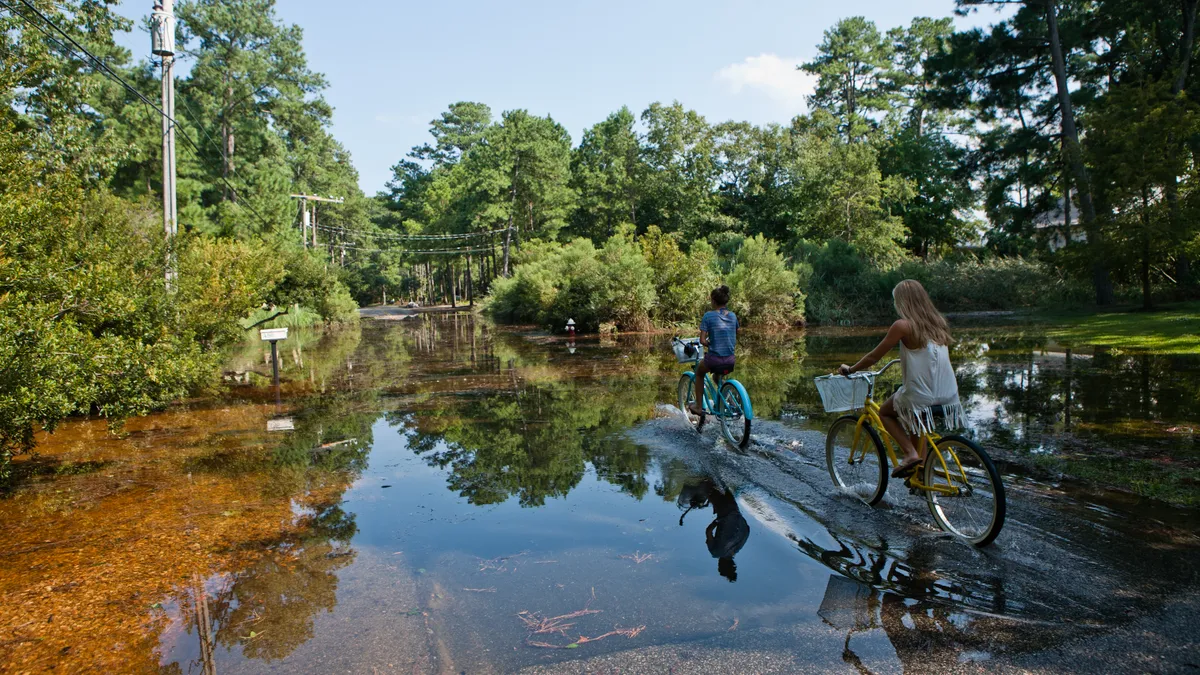New York City is sinking 1-2 millimeters a year. The northern part of Tampa, Florida, is sinking up to 6 millimeters a year. This phenomenon, called subsidence, is one that many coastal cities are facing. Urban areas are sinking while sea levels are rising, resulting in a heightened risk of floods. While the impacts may sound drastic, the issue is not always top of mind, even for officials in coastal cities, said Steven D’Hondt, a professor of oceanography at the University of Rhode Island.
“Probably most coastal city managers are aware of sea-level rise, but I think not very many of them are aware of the sinking of the shore,” said D’Hondt, who has co-authored research papers on the topic.
Local governments can take steps to minimize future flooding by enacting policy and operational changes now, say researchers and city officials.
Causes of subsidence
Engineers plan for the fact that every building causes the ground beneath it to sink somewhat in the first one to two years after construction, D’Hondt said. The more significant factor in sinking cities worldwide, however, is people removing groundwater for drinking, bathing, industrial and other uses.
Cities have sunk throughout history, D’Hondt said. For example, much of Roman-era Alexandria, Egypt, has been underwater since the second or third century AD. The modern city of almost 6 million people is expected to sink by 2100. Subsidence is also a problem in non-coastal cities such as Mexico City, where parts of the city are sinking as much as 20 inches per year.
In the near term, cities can slow the rate of sinking by no longer removing water from the ground, D’Hondt said. But they would need to find other ways to meet their water needs. For example, Tampa would need to find another source for one-third of its water, he said.
Adding water back underground can slow or stop subsidence, but it generally won’t significantly reverse it, D’Hondt said. The combination of lower buildings and higher sea levels means coastal cities must adapt to a greater likelihood of floods.
Federal and state resources
Local governments can apply for numerous funding opportunities to address sea-level rise and other climate change impacts, said Michael Dexter, director of federal programs for the Southeast Sustainability Directors Network.
FEMA programs help communities build infrastructure and improve resiliency, Dexter said. “[FEMA is] recognizing that $1 spent in resiliency before disaster might save $10 of post-disaster work,” he said.
Building Resilient Infrastructure and Communities is a grant program for projects that protect life and property from future natural disasters. The Safeguarding Tomorrow through Ongoing Risk Mitigation Act provides capitalization grants so states, tribes and territories can establish revolving loan funds that provide hazard mitigation assistance for local governments.
Some states also have their own programs. For example, the Florida Resilient Coastlines Program offers funding to coastal communities dealing with flooding, erosion and habitat shifts.
Local governments interested in grants should get in touch with their state early on to ensure a particular project fits within state and FEMA priorities, Dexter said.
One city’s approach
Virginia Beach, Virginia, faces both subsidence and sea-level rise, and it's no stranger to flooding. The coastal city was one of the first U.S. communities to join the National Flood Insurance Program administered by the Federal Emergency Management Agency, said Whitney McNamara, an environmental planner in Virginia Beach who oversees the city’s flood management program.
The Public Works Department developed a strategy for sea-level rise adaptation and updated the city’s master drainage program, McNamara said. Among its strategies, Virginia Beach requires buildings to be elevated above FEMA requirements. It also conserves open space, including several parks, in flood-prone areas. By preventing home construction in those areas, no homes are lost if they’re ever permanently underwater.
The government also restricts residential development in the southern part of the city, which is much closer to sea level. These regulations have reduced the number of potential homes that could flood, McNamara said.
“To be successful,” adapting to sea-level rise “has to be a citywide priority,” McNamara said. “You aren't going to be able to accomplish the goal with just one department.”
“One of the most useful things to me is being able to collaborate with other communities in the region to see what they’re doing, what's working well and what isn't working,” she added.
D’Hondt said over the next century, governments need to plan for the sea to rise at least a couple of meters while the shore sinks. In the long run, the best course for coastal cities to take is to build farther from the shore, he said, or on a more solid type of ground, such as bedrock, instead of on the sediment or silt on which most sinking cities are built. He also advises cities not to rebuild existing buildings if they are destroyed by a hurricane or flood.
“Then you'll be ready for 50 or 100 years down the road,” D’Hondt said.










